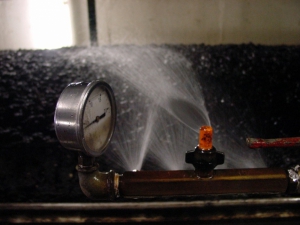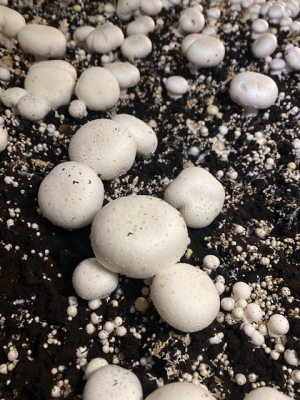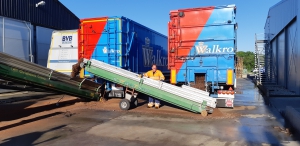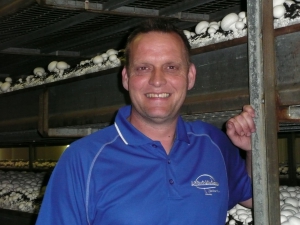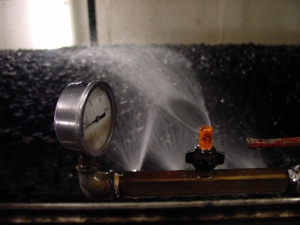Water, the ongoing discussion
If one wants to start a discussion with a grower (or with a consultant), start talking about watering.
How much, when and what watering method.
To make any sense though, you first have to define the period. There is watering on casing soil and watering over mushrooms and between flushes.
This blog is about watering on the casing soil during the incubation period. The water given in that period is to bring the casing soil up to the maximum moisture level and to keep the compost at the right moisture.
A good phase 3 compost at the moment of casing will be around 60% in moisture. For white strains that can be up to 3% higher, brown strains prefer 1 or 2% drier. It is not possible to bring the compost to a much higher moisture level by watering it after filling. It is possible to give water into the compost but that will be free water which has to disappear during the fructification period.
2 up to 4 litres of water can be given into the compost at filling or later but that should be the maximum. Even if it is necessary to cool the compost. This can better be done by giving water into the casing and let it evaporate with fresh air and circulation.
Casing soil itself can handle up to 7 litres per m² plus the water that was originally in the casing. To be sure, we talk about a casing containing white and black peat.
More than 7 litres will evaporate, go into the compost or down the drain.
Considering that the evaporation can be around 2 litres per m² per day, the loss with evaporation is about 10 litres. If you count the loss of dripping, the water staying in the compost and the evaporation you come to a figure of about 25 litres of water. In practical situations this means a total amount of water between 20 and 30 litres average. Depending on the farm and the time of the year. Growing drier often means a loss of production and growing a lot wetter means problems in growing, mainly in the outgrow of mushrooms.
Another thing to watch for is the watering method. Make sure that the pressure of the water onto the casing is not too high. Too many times I see a casing with a damaged surface which will give problems in the evaporation.
Every system has a different pressure and if you are not sure, ask the manufacturer. Regularly cleaning of the nozzles is something will help maintaining the right pressure and the right adjustment of the watering trees, looking at distance and height according to the casing level.
Keep watering but do not take it over the top!!
Tweeners
Mushrooms that grow between the 1st and 2nd break are called tweeners or in between mushrooms. They are very hard mushrooms because they had a lot of water at the end of the breaks but will discolor fast, once picked, because of that water. They are, however, white inside and are therefore extremely suitable to use for slicing. Many farms worldwide are growing tweeners, only to use them for their sliced product. However, if you have a lot of tweeners it can have a negative effect on the quantity of pins in 2nd breaks. You need to control the amount of tweeners that grow out and spread them out nicely over the whole shelf. If some spots have many tweeners together the 2nd break will not be able to develop well, and yield will be lost. On some farms I see harvest managers making some extra yield with tweeners but not realizing enough that that extra yield gets lost in the 2nd breaks, where you normally pick you nicest quality mushrooms.
That doesn’t mean you can’t grow tweeners. Some farms use them to control the quantity of the pins in 2nd breaks. Just by leaving them nicely spread over the beds you can control the amount of 2nd break mushrooms. Clean the beds good after the 1st break, don’t pick for 2 days and on the 3rd, day manage it well controlling the in between break. If you see the 2nd break coming up spontaneously you can leave some more tweeners, if the 2nd break is struggling on some spots, you must open the in between break up and pick some more there. That need to be planned and managed good to get the best benefits out of the total production.
Erik de Groot
Global Agriculture Services
This email address is being protected from spambots. You need JavaScript enabled to view it.
Filling and picking organisation.
If you look at this in a glance one might say: the filling has not that much to do with picking. But it is more relevant than many people think. Before the start of picking a first flush, the picking manager makes a plan. When is the room starting? Do I have to pick clusters or pre-runners? How many pickers do I need in this room during lets say 5 days of picking? And an important one, what is the activity of the room? This I need to interact on the growing from day 2 of picking. And this is where the filling of the room comes into the story.
Before the start of picking the picking manager and the grower have a talk about this room. This should start from the moment pins grow out, so about 4 days before the start of picking that room. The picking manager has knowledge about the expected sales that week, the desired size of the mushrooms and the number of pickers available. The grower has knowledge of the room regarding the activity of the compost, the strain and the number of pins developing. An even room is easy to evaluate but if the filling was uneven or two different types of compost were used, than the story gets a bit more difficult. The growing room will develop uneven and one side might start earlier. One side might give more mushrooms and this means that the picking is not the same on all shelves. And with the tendency to build bigger rooms, more trucks of compost are filled in a room. And every truckload of compost can be a bit different. Sometimes in structure, sometimes in moisture content and even in quantity. And every time the operator of the combine filling machine has the desire to change the settings on the machine. Often his order is to get the compost filled. All shelves full and no compost returning to the compost yard or no compost dumped. But by changing the settings the temperature development of the compost will change too. 2 cm deeper fill can result in a difference of a day for the flush to start. It will also have an effect on the number of mushrooms growing out. And during the flush one side will grow faster than the other.
So the general instruction at filling should be not to make any changes. Better a bit of compost left over or a part of the shelves not being filled. An even better way is to fill out of two trucks in one go with a cross conveyor. That way the compost out of two trucks is mixed and differences are ruled out. Another method is to do a mixed fill of the truck at the compost yard. So fill a layer, fill another layer in another truck and then let the trucks circulate. Of course the best possible way is to do the mixed filling of the truck, together with the combined unloading at filling. The growing will be a lot easier then. The grower has a better chance to produce the number of mushrooms required and the picking can be a lot more accurate.
Dry bubble (Verticillium fungicola)
One of the most seen disease in mushroom farms is the dry bubble, caused by the fungus Verticillium fungicola. Its easy to get an infection in the farm and because the disease is very infectious it can spread quickly through the whole farm. Especially in big farms, where many pickers are working, the dry bubble will spread very fast and can cause a lot of damage and be that bad that 3rd breaks may be lost. Pickers should be getting all the information about the dry bubbles so they can detect the infection in an early stage.
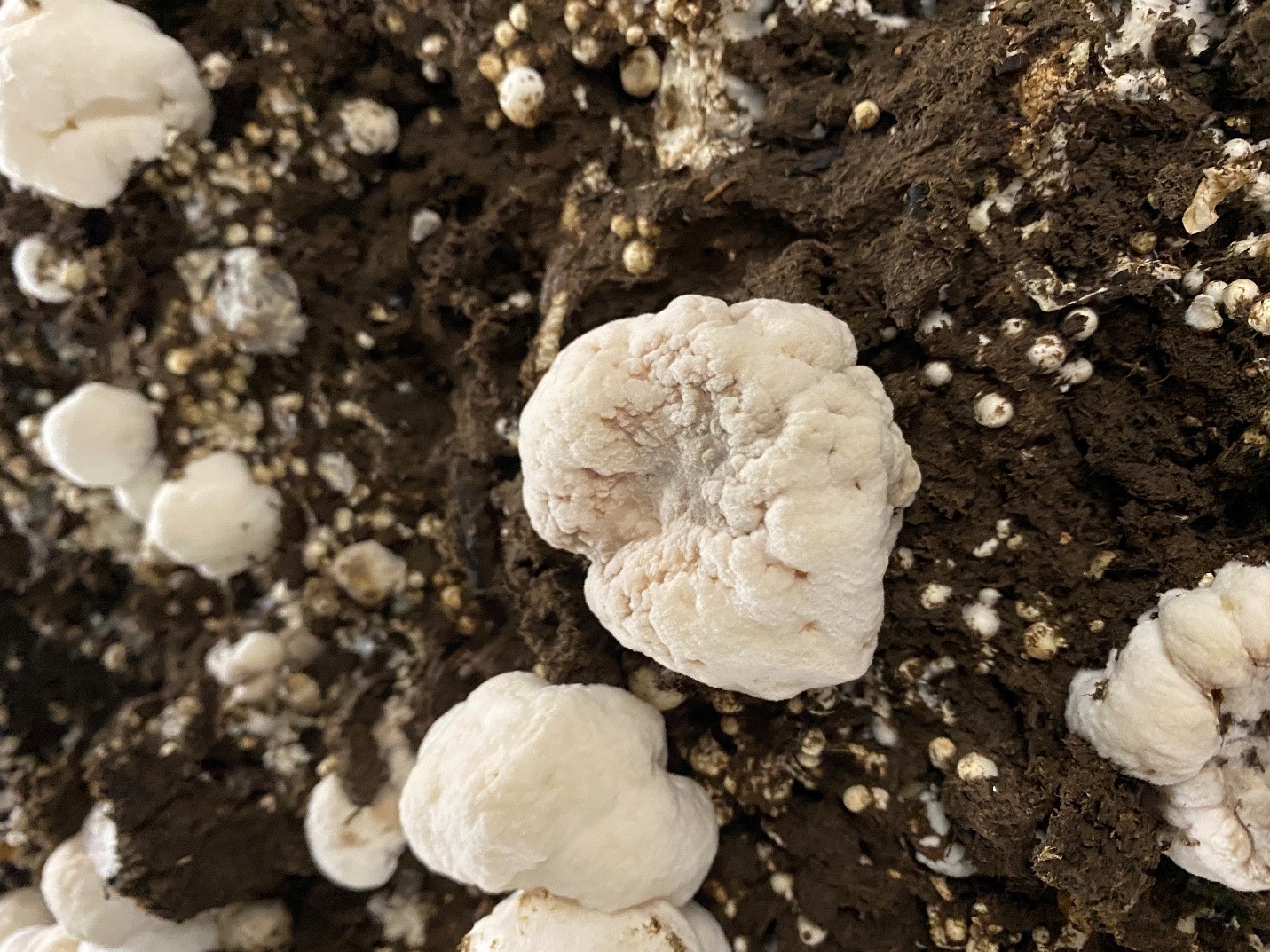
A dry bubble in a 2nd break.
Dry bubble is generally caused by spores around the farms in windy, dusty conditions. On filling days when its windy outside with dust in the air its very well possible to get the dry bubbles into the farm. When they are spotted before he 1st break, the infection came in at filling. Once inside it’s a matter of time before the spores are everywhere if not handled well. Hygiene on the farm should be checked and especially have a good look at all the materials that are used for your mushroom waste like stem bins. Spores of bubbles will be present there if not cleaned well and can be spread if materials are getting moved between rooms. Also pickers are a concern for spreading the infection. Spores are sticky so everything that gets touched after touching a bubble can get infected, be aware!!!, it can go rapidly.
Removing the bubbles is off course also very important. When the pickers don’t recognize a bubble and are picking mushrooms while touching dry bubbles it will be always be hard to control the infection rate. Educate them well and spread around as much information as you have to inform pickers about the diastase and the big risk it has on the results of the farm. Let them, or the picking lead, report the infection so a special crew can handle it the right way.
When the pickers recognize the bubbles, the next step is removing the infection as soon as possible. Makes sure when you remove the bubble you don’t spread the spores what will results in more bubbles within 4 to 5 days. Use a wet tissue to cover infected spots too avoid the spread and remove all the spot including the casing soil, using a plastic bag. Close the bag immediately after you have the bubble and surrounded casing soil inside and remove the bag from the farm as soon as possible. You can also leave it in the affected room and remove it after cook-out. After removing it use salt or ammonia to cover the infected area and inspect the area every day to see if the infection is spreading.
It all comes down to a good hygiene, organization and education. Infection can occur suddenly but if threated the right way can also be stopped rapidly. Organize it well so that infections get removed before rooms get picked or watered, those are moments when spores will spread. If everybody recognizes the disease and knows what to do and handles right, bigger problems can be avoided. Hygiene is key, not only for dry bubbles, and should never be underestimated.
Erik de Groot
This email address is being protected from spambots. You need JavaScript enabled to view it.
Water, the ongoing discussion
If one wants to start a discussion with a grower (or with a consultant), start talking about watering.
How much, when and what watering method.
To make any sense though, you first have to define the period. There is watering on casing soil and watering over mushrooms and between flushes.
This blog is about watering on the casing soil during the incubation period. The water given in that period is to bring the casing soil up to the maximum moisture level and to keep the compost at the right moisture.
A good phase 3 compost at the moment of casing will be around 60% in moisture. For white strains that can be up to 3% higher, brown strains prefer 1 or 2% drier. It is not possible to bring the compost to a much higher moisture level by watering it after filling. It is possible to give water into the compost but that will be free water which has to disappear during the fructification period.
2 up to 4 litres of water can be given into the compost at filling or later but that should be the maximum. Even if it is necessary to cool the compost. This can better be done by giving water into the casing and let it evaporate with fresh air and circulation.
Casing soil itself can handle up to 7 litres per m² plus the water that was originally in the casing. To be sure, we talk about a casing containing white and black peat.
More than 7 litres will evaporate, go into the compost or down the drain.
Considering that the evaporation can be around 2 litres per m² per day, the loss with evaporation is about 10 litres. If you count the loss of dripping, the water staying in the compost and the evaporation you come to a figure of about 25 litres of water. In practical situations this means a total amount of water between 20 and 30 litres average. Depending on the farm and the time of the year. Growing drier often means a loss of production and growing a lot wetter means problems in growing, mainly in the outgrow of mushrooms.
Another thing to watch for is the watering method. Make sure that the pressure of the water onto the casing is not too high. Too many times I see a casing with a damaged surface which will give problems in the evaporation.
Every system has a different pressure and if you are not sure, ask the manufacturer. Regularly cleaning of the nozzles is something will help maintaining the right pressure and the right adjustment of the watering trees, looking at distance and height according to the casing level.
Keep watering but do not take it over the top!!














